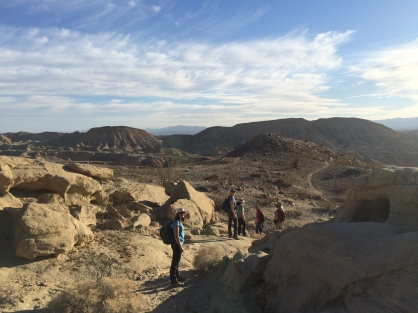Last winter, after half a decade of drought, the rains fell early and often across the state of California. By March, the deserts and grasslands were alive in a glorious riot of wildflowers–a genuine, bona fide Super Bloom. I joined the birds and bees, moths and mammals to greet those colorful fields of corollas. This March…well…it’s shaping up to be firmly less floral. The past few days, however, hope in the form of charcoal clouds and chilly rain showers. Will we have a miracle this March? Will my army of amazing annuals be delayed, but not dormant? Will I decide I’ve already used ample alliteration and alter my approach? I’m ready to ramble on regardless!
A couple weeks ago I met some friends in Anza Borrego State Park in Colorado Desert.

I had every intention of ditching them to look for blog content (a.k.a. rare plants), but it was as dry as a desert out there! I wasn’t completely skunked, but it was close. All and all, I saw maybe 10 species in bloom. While there were no annuals in sight, desert shrubs are a tough bunch. Their deep taproots and water storage abilities mean that some of them can bloom on schedule, even in the driest years. The toughest among them don’t even bother with leaves while they flower. Case and point, Asclepias albicans (White-stemmed Milkweed, Asclepiaceae).
This is definitely the most hard-core milkweed I’ve ever met (and, incidentally, the tallest). It was happily blooming away on a bone-dry hillside in the Carrizo Badlands, basically just some chalky sticks and wonky flowers.
Another leafless wonder is Psorothamnus spinosus (Smoke Tree, Fabaceae), with its orange gland-dotted calyx. It’s quite a large shrub that commonly grows in dry washes.

I only have one other plant to post from the trip. This one does have leaves and more normal flowers, but I think it’s pretty great anyway, as it’s rare–only found on the western edge of the Colorado Desert. Xylorhiza orcuttii (Orcutt’s Woody Aster, Asteraceae).
I also get to add this species to my growing collection of “plants seen with crab spiders” (check out the right picture).
I wish I had more to offer up (and better photos, the light was consistently terrible!), but this trio will have to serve as an tiny appetizer until next time. My current plan is to see if thing are bloom-ier in Death Valley next weekend. If not, my best bet will be to ramble much further North!



